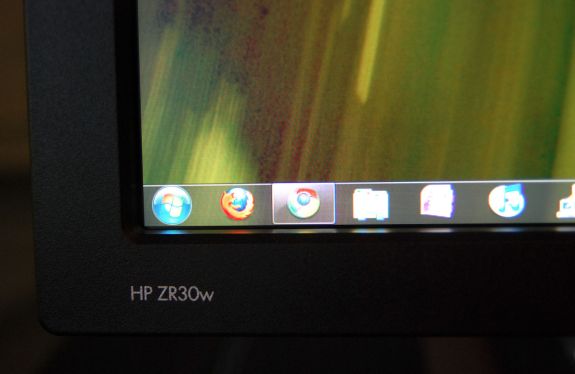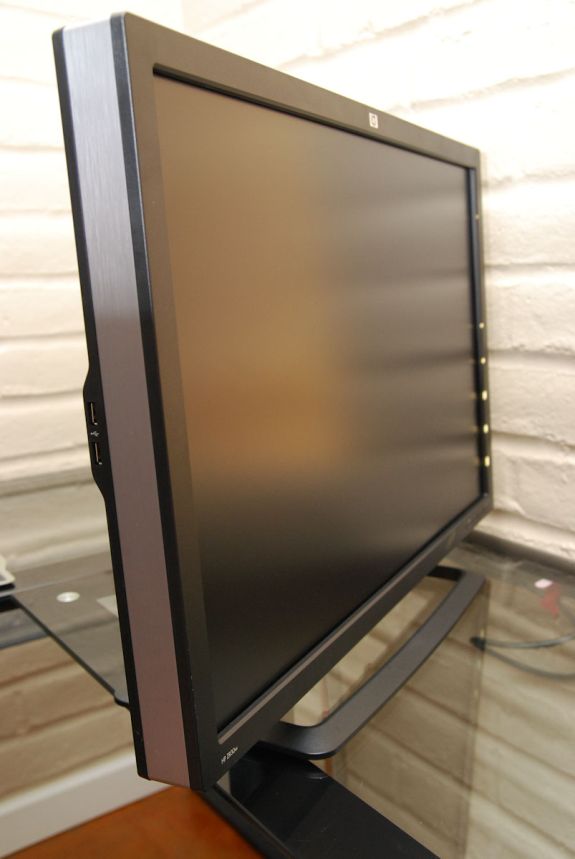A New 30" Contender: HP ZR30w Review
by Brian Klug on June 1, 2010 6:30 PM EST
Opining for an OSD
As I mentioned before, there’s no OSD to speak of. The only options exposed to users are input selection, brightness, and dynamic contrast. A blue LED at right flashes three times when you’ve reached the upper or lower brightness limits, and flashes four times when dynamic contrast is turned on, once when turned off. The LED is off when the display is in operation, and amber when in standby. The rest is up to you.
Spartan Scaling Selections
I also already touched on scaling which appears to be pretty barebones for reasons discussed earlier. You can pixel double by going with 1280x800, or go for native, or choose another resolution and everything upscaled with some smudging. There's no 1:1 option, or any options whatsoever. Honestly, I can’t think of any reasons why you wouldn’t drive an LCD at anything other than native resolution. The dot pitch of the ZR30w is fabulous at 0.250 mm, if you’re paying for those pixels, use them, then use DPI controls in the operating system if text and UI is too small. The ZR30w does scale other aspect ratios that I tested properly, but don't expect too much. Honestly it still makes no sense to drive a display this high resolution at anything but native.
Final Thoughts
The 30” segment of the LCD market demands the best of the best. It’s indisputably the ring in which every manufacturer wages battle with its flagship monitor. Solid execution here usually translates to solid performance for smaller size panels in the same lineup. Suffice it to say that HP’s 30 inch ZR series successor to the LP3065 doesn’t disappoint.
Spartan Scaling Selections
I also already touched on scaling which appears to be pretty barebones for reasons discussed earlier. You can pixel double by going with 1280x800, or go for native, or choose another resolution and everything upscaled with some smudging. There's no 1:1 option, or any options whatsoever. Honestly, I can’t think of any reasons why you wouldn’t drive an LCD at anything other than native resolution. The dot pitch of the ZR30w is fabulous at 0.250 mm, if you’re paying for those pixels, use them, then use DPI controls in the operating system if text and UI is too small. The ZR30w does scale other aspect ratios that I tested properly, but don't expect too much. Honestly it still makes no sense to drive a display this high resolution at anything but native.
Final Thoughts
The 30” segment of the LCD market demands the best of the best. It’s indisputably the ring in which every manufacturer wages battle with its flagship monitor. Solid execution here usually translates to solid performance for smaller size panels in the same lineup. Suffice it to say that HP’s 30 inch ZR series successor to the LP3065 doesn’t disappoint.
We would’ve liked to see just a bit more color accuracy, but the tradeoff for a dramatically bigger gamut is a good one to make. The ZR30w blew past the advertised 99% of AdobeRGB, coming in at just over 111% of the volume. It’s important to note that HP likely means coverage overlap of 99%, which the ZR30w does meet. But heck, having a volume bigger than the AdobeRGB volume is more notable. In person, the ZR30w is impressive all around. It’s bright, contrasty, and has colors that put my daily use monitors and others I’ve got laying around to shame; not an easy thing to do.
At an MSRP of $1,299, the ZR30w is priced aggressively and below its predecessor and competition. If you don’t mind lacking an extra DVI port, the increase in gamut volume is a notable difference. It’s likely that both lack of an OSD as well as accessory VGA, HDMI, component or composite inputs is related to the lack of a compatible control IC. Instead, there’s likely a simple scaler so we see minimal processing lag for an IPS panel, and unfortunately minimal user control. This is a bold move on HP’s part to continue for a second generation, but likely keeps cost and input processing lag low.
At an MSRP of $1,299, the ZR30w is priced aggressively and below its predecessor and competition. If you don’t mind lacking an extra DVI port, the increase in gamut volume is a notable difference. It’s likely that both lack of an OSD as well as accessory VGA, HDMI, component or composite inputs is related to the lack of a compatible control IC. Instead, there’s likely a simple scaler so we see minimal processing lag for an IPS panel, and unfortunately minimal user control. This is a bold move on HP’s part to continue for a second generation, but likely keeps cost and input processing lag low.
Interestingly enough, this is definitely the way that things are going for display controls, with a growing number offering DDC control as the exclusive option for tweaking settings. In practice, what HP offers with the front controls is almost all you need, so long as you can calibrate to your liking in software. Perhaps we might have gotten under a Delta E of 1.0 with some RGB sliders, but who’s to say?
The ZR30w is definitely a serious contender among 30” displays. It’s an attractive package that wows with above average color tracking, an impressive gamut, and a competitive price, but lacks some of the extra “accessory” inputs that consumers are starting to demand. That said, it looks like the ZR30w is a solid option if you’re looking for a 30” display with an unbeatable color gamut.












95 Comments
View All Comments
MamiyaOtaru - Wednesday, June 2, 2010 - link
are they always s-ips? I love my lp2065, but I had to find one that was advertised specifically as s-ips since not all of them were D:Teemax - Wednesday, June 2, 2010 - link
Excellent review! I appreciate the efforts in measuring the input lag!Looks like my Dell 3007WFP finally has a worthy replacement.
Mr Perfect - Wednesday, June 2, 2010 - link
Yes, I'm glad to see it compared to a CRT rather then a "good enough" LCD with unknown input lag.Earballs - Wednesday, June 2, 2010 - link
I guess I have to assume it's 60Hz?Earballs - Wednesday, June 2, 2010 - link
redacted.melgross - Wednesday, June 2, 2010 - link
I've given up on the idea of moving to 30" from 24". I use my monitors mostly for Photoshop, video editing, publishing, etc. I've found that even IPS displays of various types show a change in brightness and contrast in the sides from sitting at the distance required for this work. Because of the large size, you're always looking at the edges at an angle that will make the difference noticeable.I've been looking at the new 27" displays for that reason. Apple's new 27" iMac doesn't have as much of a problem because of the slightly smaller size, but with the LED backlighting, they only claim an sRGB gamut. It's pretty good, but not for what I need.
Is the NEC on your to do list? I hope so. The Dell 2711 hasn't proven to be all that great.
omf - Wednesday, June 2, 2010 - link
Thanks for the detailed review! It seems rare to get good, technical data in reviews these days...I'm surprised you haven't included tests for the Dell 3008 display, though. I've heard mixed things about it and would love to see some test results.
Thanks again!
R4F43LZiN - Wednesday, June 2, 2010 - link
I would like to see a full "how to calibrate your display" one of those days here on AT. I mean, there are a few of those on the internet, but none with the kind of detail and technical aspects that we've come to expect from a AT article.MauveCloud - Wednesday, June 2, 2010 - link
"Considering other 30” displays include a plethora of input options"From my research of 2560x1600 monitors, only the Gateway XHD3000 (which I use now, though I had to get it repaired a couple of weeks ago - I did the research on possible replacements) and the Dell 3008WFP have component inputs, or are you referring to 30 inch televisions, with native resolution 1920x1080, rather than 2560x1600?.
"The ZR30w has no OSD. If you recall, neither did its predecessor, the HP LP3065. At that time, HP claimed there were no ICs that could drive an OSD at native 2560x1600 resolution. Apparently this is still the case."
My Gateway XHD3000 has an OSD at 2560x1600 (albeit not fullscreen), and so does the Dell UltraSharp 3008WFP.
phoible_123 - Wednesday, June 2, 2010 - link
I've used this cable to connect a macbook pro to my 23" NEC monitor with Displayport:http://www.buy.com/prod/mini-displayport-to-displa...
It actually transmits sound as well if the monitor has an integrated speaker.